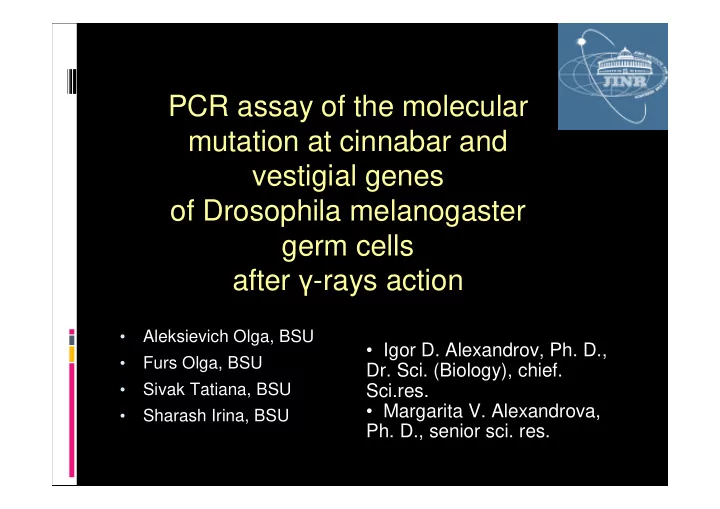

PCR assay of the molecular mutation at cinnabar and vestigial genes of Drosophila melanogaster germ cells after γ -rays action • Aleksievich Olga, BSU • Igor D. Alexandrov, Ph. D., • Furs Olga, BSU Dr. Sci. (Biology), chief. • Sivak Tatiana, BSU Sci.res. • Margarita V. Alexandrova, Sharash Irina, BSU • Ph. D., senior sci. res.
Project aim Project aim TO STUDY THE MOLECULAR GENETIC ACTION OF GAMMA-RAYS ON THE CINNABAR AND VESTIGIAL GENES IN DROSOPHILA MELANOGASTER GERM CELLS
Drosophila melanogaster , species is commonly known as the common fruit fly or vinegar fly. One of the best model organism in genetics and radiobiology because: § Well studied example, gene structure known § Has common principal DNA structure with humans § Short life cycle (~10 days) § Permits the study of heritable gene mutation § Low cost
Wild phenotype of Drosophila melanogaster γ -rays γ -rays Phenotype of vestigial gene Phenotype of cinnabar gene mutants mutants
Main steps Main steps
DNA isolation DNA isolation - cell lysis - DNA sorbtion with Silica Solution - DNA purification using washing buffer - DNA extraction using Extra Gene
P olymerase C hain R eaction - PCR - to amplify specific fragment of DNA - method based on in vitro replication of DNA using: Taq polymerase primers dNTP reaction buffer
Electrophoresis ! !
Visualization - using ethidium bromide - dye intercalates beetween bases red- -orange orange red UV UV UV UV EM Max AB Max
Schem e of ves t i gi al gene
Ex 5 Ex 3 Ex 6-8 Ex 4 Ex 1 Ex 2
in 1 in 2-2 in 3 in 2-3 in 2-4
V es t i gi al m ut ant s w i t h g é not ype Phr № ex6-8 Mutation code Dose ex1 (983b) ex2 (777b) ex3 (471b) ex4 (381b) ex5 (670b) (768b) 1 + + + + + + Phr14 2 + + + + + + Phr16 γ , 40 3 + + + + + + vg89e19 4 γ , 40 + + + + + + vg89e20 5 γ , 40 + + + + + + vg89e23 6 γ , 40 + + + + + + vg89e47 7 γ , 40 + + + + + + vg89e64a 8 γ , 40 + + + + + + vg89e88 9 γ , 40 + + + + + + vg89e104b
In2-2 In2-3 In2-4 in1 (983b) in3 (768b) (471b) (381b) (670b) Mutation code Dose № 1 8 10 15 16 1 Phr14 + + + + + 2 + + + + + Phr16 3 γ , 40 + + + + + vg89e19 4 γ , 40 + + + + + vg89e20 5 γ , 40 + + + + + vg89e23 6 γ , 40 + + + + insertion vg89e47 γ , 40 7 + + + + + vg89e64a 8 γ , 40 + + + + + vg89e88 9 γ , 40 + + + + + vg89e104b
Res ul t s § 2 control lines and 7 mutants ( γ -irradiated) were examined § 8 exones and 3 intrones of vestigial gene were analyzed § 1 insertion was detected in 3 d introne of 1 vestigial gene mutant § More than 60 polymerase chain reactions were carried out
Concl us i ons § Such a little quantity of PCR-detected deletions could be caused by specific action of γ -rays. Because the type of radiation mentioned above induce point damage (as a rule) that cannot be detected by PCR § Mutant phenotype can be caused by changes in exones and intrones of the gene
St r uct ur e of t he ci nnabar gene
Vi s ual i z at i on of El e ct r ophore s i s Us i ng UV Li ght Fragment 1 Fragment 2 Fragment 3
PCR r es ul t s of t he 1 s t , 2 nd and 3 t h f r agm ent s of t he ci nnabar gene Fragments № № of fond № of mutations Dose Genotype 1st 2hd 3th 40 Gy γ Cn[74 b 2]vg/ Cy 2004 1 Cn3 D-18 + + + 40 Gy γ 2 Cn4 Cn[74 b 3]/Cy0 D-18 + + + 40 Gy γ Cn[74 b 4] /Cy 204 3 Cn5 D-32 + + + 40 Gy γ Cn[78 k 1]/Cy 204 4 Cn36 D-32 + + + 40 Gy γ Cn[81 l 4] /Cy 2004 5 Cn78 D-32 + + + 40 Gy γ Cn[83 b 27] /Cy 204 6 Cn-n83+In D-32 + + + 20Gy γ Cn[87 l 80]vg/ Cy 2004 7 Cn114 D-32 + + + 10Gy γ Cn[87 f 149]/ Cy 204 8 Cn122 D-32 + + + 60Gy γ 9 Cn140 Cn[88 d 7]/CyO D-32 + + + 2,5 Gy, 12 C Cn[10d3-4]/Cy 204 10 Cn198 D-18 + - +
Concl us i ons Gamma-rays induce point damage (as a rule) that cannot be detected by PCR Only 1 PCR-detected deletion was observed. It can be caused by high-dense irradiation of the mutant
G ener al Concl us i ons § We have studied the molecular alterations induced by ionizing radiation at 2 Drosophila genes with different sizes, structure and position on the chromosomes. § Two different genes-targets react in the same way on the action of radiation. It is suggested that different position of 2 genes on the chromosome and difference in sizes don’t influence on their radiomutability. § Mutations can be caused by changes in intrones and exones
Thanks f or your at t ent i on!
Recommend
More recommend